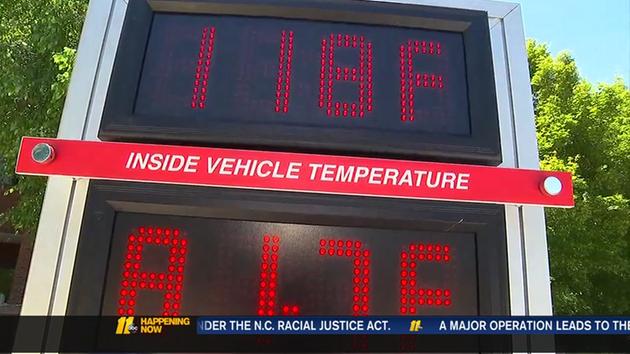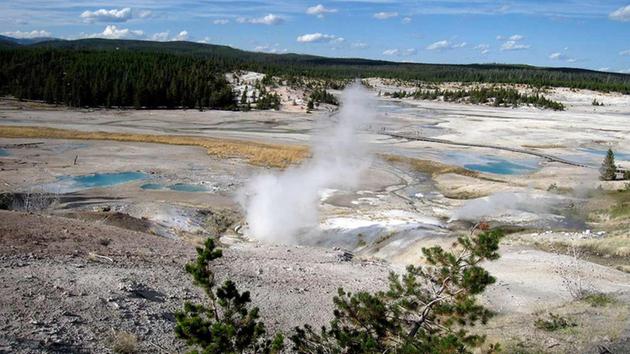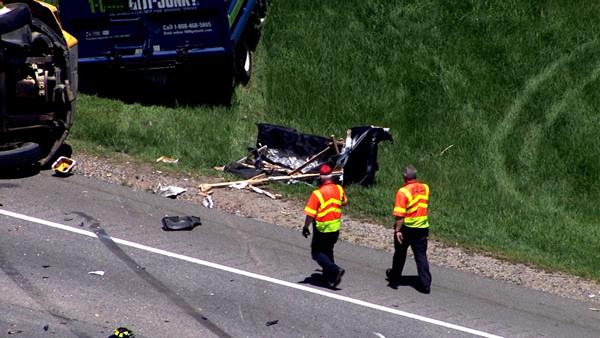One driver dead in fiery head-on collision north of Hastings, NE
By NBC Nebraska |
Posted: Wed 11:34 PM, Jun 08, 2016 |
Updated: Thu 10:09 AM, Jun 09, 2016
HASTINGS, Neb. -- Nebraska State Patrol has identified the man who was killed in a two-vehicle crash north of Hastings Wednesday night.

NSP told NBC Nebraska 71-year-old Robert J. Samuelson, of Hastings, died after a northbound vehicle, a black Lincoln, crossed the median of Highway 281 near the intersection of 82nd street and collided with his Chrysler head on.
The driver of the northbound vehicle was taken to Mary Lanning Healthcare with unknown injuries.
NSP says the Chrysler became fully engulfed in flames after the collision and both vehicles ended up in the ditch to the west of the southbound lanes.
The vehicle fire spread to the trees in the nearby ditch, causing both the Hastings Rural Fire Department and the Hastings Fire Department to battle the blaze.
Both fire departments were joined by the Nebraska State Patrol and Adams County Sheriff's Department on scene.
Southbound lanes on Highway 281 and one northbound lane were closed for several hours as investigators work to reconstruct the scene.
The name of the person driving the northbound vehicle has not been released.
NSP is still investigating at this time what caused the northbound driver to cross the median into the southbound lanes.
Both lanes of Highway 281 are back open.
Sanitation worker killed when garbage truck rear-ended by motorist
By Carol Robinson | crobinson@al.com
on June 09, 2016 at 2:26 PM, updated June 09, 2016 at 3:51 PM
 Jamie DickeyFacebook
Jamie DickeyFacebook
A 34-year-old sanitation worker was killed this morning when the truck he was riding on was struck by another motorist.
The Cullman County Coroner's Office identified the victim as Harold "Jamie" Dickey. He was a husband, and father of two.
The crash happened at 7:50 a.m. on U.S. Highway 231 South, said Coroner Jeremy Kilpatrick. Dickey was on the back of the garbage truck when he was hit by a pickup truck. Arab police and Alabama State Troopers responded to the scene.
Dickey was taken to Marshall Medical Center North, where he was pronounced dead, Kilpatrick said. The pickup truck that struck Dickey was heavily damaged, but the driver received only minor injuries.
"We're mourning for him,'' said Cullman County Attorney Chad Floyd. "It's a tough day for the county. We've never lost anyone like this before."
Grief counselors are being made available to Dickey's co-workers on Friday.
"Our employees are dedicated to public service, and Jamie was no exception. Jamie was a valuable part of our County work force, and he will be greatly missed,'' said Kenneth Walker, chairman of the Cullman County Commission. "Our thoughts and prayers go out to Jamie's family, his wife and children."
The investigation is ongoing by Alabama State Troopers.
Brittany Horn and Alonzo Small, The News Journal 10:34 a.m. EDT June 8, 2016

(Photo: Alex_Schmidt, Getty Images/iStockphoto)
One person is dead following a fatal crash Tuesday afternoon on Bay Road in Little Heaven, according to state police.
The crash, which occurred about 1:55 p.m. on southbound Del. 1 just south of Clapham Road, involved an SUV and a van.
Heath B. Janssen, 41 of Dover, was pronounced dead at the scene, Master Cpl. Gary Fournier said. Janssen, a Verizon employee, was placing equipment into the back of his work truck after checking a phone line in the area, Fournier said. Janssen's work vehicle, a 2006 Ford F36 box truck, was pulled over on the southbound shoulder surrounded by cones near the entrance of the Valero gas station on 7865 Bay Road, Fournier said.
Meanwhile, Zachary M. Krytzer, 27 of Milton, was operating a 2002 Mitsubishi Montero on southbound Del. 1 (Bay Road) just south of Clapham Road.
Police say Krytzer's Montero drifted onto the southbound shoulder and struck a mailbox and road reflector, before striking and pinning Janssen to the rear of his work truck.
Witnesses from the scene say Krytzer's Montero was weaving in and out of traffic prior to the crash, Fournier said.
The Verizon truck was pushed forward approximately 36 feet on the southbound shoulder while Krytzer's Montero continued southbound for an additional 23 feet before coming to a stop, Fournier said.
Krytzer, who was wearing a seat belt at the time of the crash, was treated for non-life threatening injuries at the Bayhealth Kent General Hospital, Fournier said.
The State Police Collision Reconstruction Unit was at the crash and continue to investigate the incident, Fournier said.
Del. 1 southbound was closed at Clapham Road for three and a half hours while the crash was investigated and cleared.
Proposed EPA Cleanup Plan will make Portland Harbor safer and healthier for all
Agency sets 60-day comment period and schedules four public meetings -- public encouraged to provide comment
06/09/2016
Contact Information:
Judy Smith (smith.judy@epa.gov)
503-326-6994
(Portland – June 8, 2016) The U.S. Environmental Protection Agency has released its Proposed Plan to clean up the in-water portion of the Portland Harbor Superfund Site, an industrial waterway covering approximately 10 miles of the Lower Willamette River, from Broadway Bridge to the Columbia Slough. EPA proposes to dredge and cap the most contaminated sediment throughout the 10-mile stretch of the Lower Willamette, in areas where concentrations pose the highest risk to people, fish, and wildlife.
Other, less contaminated areas will be monitored and allowed to recover naturally. At the end of construction, EPA estimates that cancer and other serious risks posed by contamination will be greatly reduced – in many places up to 100 times lower than it is now. Natural recovery will further reduce these risks to levels deemed acceptable under Superfund and Oregon Department of Environmental Quality (ODEQ) cleanup programs, but will not eliminate all risks. Active cleanup work under the selected Alternative I is estimated to take seven years and cost approximately $750 million.
Release of the proposed cleanup plan starts a 60-day public comment period, which EPA extended from the required 30 days in response to public requests for a longer comment period. The public is encouraged to provide formal comments on the plan to EPA by August 8, either in person at public meetings, online or in writing. (Comment period information below)
“The time has come to clean up the Lower Willamette, the lifeblood of Portland’s environment and economy,” said EPA Regional Administrator Dennis McLerran “Our proposed cleanup plan is based on the best science and most effective cleanup technologies. Our aim is to make Portland Harbor healthier and safer for all who treasure and rely on it. We also expect our cleanup to serve as an engine for local economic development by generating construction jobs while the project is underway, and leading to an important economic revival by providing certainty for future development.”
McLerran’s sentiments were echoed by Jim Woolford, Director of the Office of Superfund and Remediation and Technology Innovation in EPA’s Headquarters Office in Washington, D.C.
“Release of this plan is a significant milestone in the path to cleaning up the Portland Harbor Site,” said Woolford, Director of EPA’s Office of Superfund Remediation and Technology Innovation in Washington, D.C. “My office has been working with EPA Region 10 and we believe the proposed alternative is a sound cleanup approach that is consistent with national regulations and policies.”
The Agency engaged and closely consulted with the ODEQ, six federally recognized tribes and a wide variety of public and private stakeholders while developing the Remedial Investigation and Feasibility Study, which are the basis for the Proposed Plan. Under a 2001 agreement with ODEQ, EPA manages the cleanup of the in-water cleanup portion of the site and ODEQ is responsible for the upland portion of the site. ODEQ’s ongoing pollution source control work will complement EPA’s cleanup work in the harbor.
“DEQ appreciates the extensive work performed by the many businesses and state and local governments who partnered with DEQ over the past 15 years to investigate and cleanup the upland and upriver sources of contamination that could potentially re contaminate Portland Harbor,” said Joni Hammond, ODEQ’s Deputy Director. “We now look forward to focusing our efforts on reviewing EPA’s Proposed Plan and working with EPA to implement the cleanup in a timely manner.”
More than 40 contaminants were found in river sediment at concentrations that pose a risk to people, fish and wildlife. Some of the contaminants include: polychlorinated bi-phenyls (PCBs), dioxins/furans, pesticides (DDT and its byproducts), and poly aromatic hydrocarbons (PAHs). Resident fish and shellfish accumulate contaminants that are harmful to people and wildlife. People who eat resident fish are most at risk from contaminants at the site. The main goal of the cleanup is to reduce levels of contaminants in fish to allow for human consumption. In addition, productive re-use of valuable commercial property is also another important benefit of cleanups, according to EPA’s Regional Administrator.
EPA’s proposed cleanup addresses contaminated sediments through dredging, capping, armoring or enhanced natural recovery, including removal of over 1,400,000 cubic yards of contaminated sediments. Approximately 1,900 acres of the site with lower contaminant levels are expected to recover naturally over time.
EPA has increased outreach to the greater Portland community, offering information sessions, webinars and open houses to help the public understand what the contamination is, where it is and why cleanup is needed. The public is encouraged to provide formal comments on the plan by August 8.
Four public meetings will be held in and around Portland where EPA will explain the Proposed Plan and where public comments will be accepted and recorded.
These public meetings are scheduled for the following dates, times & locations:
June 24, 2016, 11:30am-8pm, City of Portland Building, 1120 SW 5th Ave.
June 29, 2016, 11:30am-8pm, EXPO Center, 2060 N Marine Dr.
July 11, 2016, 11:30am-8pm, University Place Conference Center, 310 SW Lincoln St.
July 20, 2016, 11:30am-8pm, Ambridge Center, 1333 NE Martin Luther King Jr. Blvd
EPA will offer two presentations on the Proposed Plan during each public meeting at the following times: 12noon-12:30pm and 6pm-6:30pm.
All locations are easily accessible via MAX trains and bus lines.
Russian, Spanish, Vietnamese, and Chinese interpreters will be available during the June 24th meeting. Please notify Laura Knudsen (knudsen.laura@epa.gov) or 503-326-3280, no later than two weeks prior to a public meeting to request language interpretation assistance.
Comments can be submitted to EPA via:
Online: Portland Harbor Proposed Plan comment form
Email: harborcomments@epa.gov (form letters and petitions should be submitted to this e-mail address)
Postal mail: Attn: Harbor Comments, U.S. EPA, 805 SW Broadway St., Suite 500, Portland, OR 97205
In-person at an official EPA public meeting: We will accept oral and written comments on the Proposed Plan at the public meetings listed above.
All Comments must be postmarked by midnight, August 8, 2016.
All comments will be recorded, considered and responded to in a document that will accompany the final cleanup plan or “Record of Decision,” expected in late 2016.
EPA encourages the public to review the Proposed Plan, fact sheet and other documents at:
EPA’s Portland Harbor website
Multnomah County Central Library, 801 SW 10th Avenue, Portland, Or
St. Johns Library, 7510 N Charleston Avenue, Portland, OR
Kenton Library, 8226 N Denver Ave, Portland, OR
EPA Region 10 Oregon Operations Office, 805 SW Broadway St., Suite 500, Portland, OR, 503-326-3250 (please call for an appointment)
EPA Region 10 Superfund Records Center, 1200 Sixth Avenue, Seattle, WA, 206-553-4494 (please call for an appointment)
Contact Us to ask a question, provide feedback, or report a problem.



06/09/2016
Contact Information:
Joshua Singer (singer.joshua@epa.gov)
312-353-5069
(CHICAGO—June 9, 2016) The U.S. Environmental Protection Agency (EPA) and the Department of Justice today announced an agreement with Ohio-based Marathon Petroleum Company that will reduce air pollution from the company’s refinery in Detroit and also from refineries in four other states.
Under the agreement, Marathon will spend approximately $6 million to shut down a flare at the fence line of its Detroit refinery on Schaefer Road by December 2018. Marathon will also install two new state-of-the-art systems that capture and recycle gases that would otherwise be sent to the Refinery’s flares at a cost of $36 million. Through this agreement, sulfur dioxide emissions from the Detroit Refinery will be reduced by 28 tons per year starting in July and then reduced by an additional 7 tons per year starting in 2019. Other pollutants, such as volatile organic compounds, nitrogen oxide, and greenhouse gases will also be reduced through the required upgrades.
“The Detroit area has one of the highest asthma rates in the nation,” said acting EPA Regional Administrator Robert Kaplan. “Today’s agreement is a step in the right direction to improve air quality in a neighborhood that has been overburdened by pollution.”
“This agreement continues the significant pollution reductions achieved under our earlier consent decree with Marathon in 2012,” said John C. Cruden, Assistant Attorney General of the Justice Department’s Environment and Natural Resources Division. “All five communities near these refineries will breathe cleaner air as a result of this agreement and Detroit will see a reduction in flaring at the refinery’s fence line.”
“This agreement marks significant progress in environmental justice in southwest Detroit,” said U.S. Attorney Barbara L. McQuade, of the Eastern District of Michigan. “It shows that industry can thrive while protecting the environment. By investing in technology, Marathon will improve air quality for all of our residents throughout southeastern Michigan.”
The settlement filed today in the U.S. District Court in Detroit amends a 2012 consent decree involving the company’s flares. A flare is a mechanical device, ordinarily elevated high off the ground, used to combust waste gases.
By installing advanced pollution controls at its refineries, Marathon will help reduce emissions that can cause respiratory and cardiovascular health impacts, which can disproportionately affect low-income and vulnerable populations, including children.
Overall, this consent decree amendment impacts Marathon petroleum refineries in five states. In addition to the $36 million in new flare gas recovery systems (FGRSs) that Marathon will spend at Detroit, Marathon will spend another $283 million for five other FGRSs at facilities in Illinois, Kentucky, Louisiana, and Ohio, for a total of $319 million. Marathon will be required to operate all of its new FGRSs, including the two new ones at Detroit, at a higher percentage of time than EPA has ever secured in prior enforcement actions. Marathon will also maintain two duplicates of a critical spare part to be delivered immediately to any of these refineries as necessary, to help make sure the FGRSs have minimal downtime. Marathon will also spend $9.55 million for nitrogen oxide (NOx) control equipment at its Ohio and Louisiana refineries and pay a civil penalty of $326,500 to the United States.
When fully implemented, today’s agreement is expected to reduce harmful air pollutants like volatile organic compounds (VOCs), sulfur dioxides (SO2) and NOx by approximately 1,037 tons per year. Under the original Consent Decree in 2012, Marathon agreed to reduce air pollution from flares by generating less waste gas and by installing equipment designed to make flares burn more efficiently. The 2012 settlement has reduced emissions of VOCs and SO2 by over 5,200 tons per year.
Under the settlement, some of Marathon’s obligations under the 2012 agreement to ensure high flare combustion efficiency will eventually be replaced by Marathon’s obligation to comply with a new, 2015 EPA rule on flare combustion efficiency. At four refineries, compliance with an EPA flare standard related to SO2 will be extended for a limited period. The projected temporary increase in pollution related to those extensions will be more than offset by simultaneous decreases that will continue indefinitely.
To learn more about the settlement and to read a copy of the consent decree, visit:
https://www.epa.gov/enforcement/first-amendment-2012-us-v-marathon-petroleum-co-clean-air-act-consent-decree
To learn more about EPA’s civil enforcement of the Clean Air Act, visit: https://www.epa.gov/enforcement/air-enforcement
To learn more about EPA’s refinery initiative, visit:
https://www.epa.gov/enforcement/petroleum-refinery-national-case-results
Contact Us to ask a question, provide feedback, or report a problem.
EPA Finalizes Agreement with New York City on Combined Sewer Overflow Tank Design and Location as Part of Gowanus Canal Cleanup
Location of Eight Million Gallon Sewage Tank Finalized
06/09/2016
Contact Information:
Elias Rodriguez ( rodriguez.elias@epa.gov)
(212) 637-3664
The U.S. Environmental Protection Agency (EPA) today finalized an agreement with the City of New York that secures the design of the larger of two combined sewage and storm water overflow (CSO) retention tanks, which are key components of the Gowanus Canal cleanup, including both the tank’s size and location. It also requires New York City to undertake activities to prepare that location for the tank installation and to pay EPA’s oversight costs. Prior to finalizing the agreement with New York City, the EPA accepted comments from the public for 45 days and attended two Brooklyn community meetings to explain the proposal. A response to the public comments has been issued with the final order.
The final administrative agreement and order released today allows New York City to locate an eight million gallon retention tank in New York City’s preferred location, known as the “Head-of-Canal” location, but it also holds the city to a strict schedule with monetary penalties imposed if violations of the schedule occur. Also, the EPA can require New York City to place the tank in the Thomas Greene Park location instead if certain activities do not occur on schedule, including if New York City is not able to acquire the land at the Head-of-Canal location within approximately four years. Locations for staging and other work related to the construction of the 8 million gallon retention tank will be acquired by New York City as part of the ongoing design phase of the project.
“The New York City Parks Department prefers not to have a large sewage retention tank
permanently located in a city park,” said Judith A. Enck, EPA Regional Administrator. “The EPA is committed to preserving urban parkland and worked with the City of New York on this alternate location. This alternate location meets the dual goals of cleaning up the canal while also protecting urban parkland.”
More than a dozen contaminants, including polycyclic aromatic hydrocarbons (PAHs), polychlorinated biphenyls (PCBs) and heavy metals such as mercury, lead and copper, were found at high levels in the sediment in the Gowanus Canal. PAHs and heavy metals were also found in the canal water. PAHs are a group of chemicals that are formed during the incomplete burning of coal, oil, gas, wood, garbage or other organic substances. PCBs were used as coolants and lubricants in transformers, capacitors and other electrical equipment, and their manufacture was banned in 1979. PCBs and PAHs are suspected of being cancer-causing and PCBs can have neurological effects as well. To this day, people can still be found fishing in the Gowanus, despite advisories about not eating fish from the canal. In 2010, the Gowanus Canal was added to EPA’s Superfund list of the nation’s most contaminated hazardous substance sites.
The EPA issued its final cleanup plan for the Gowanus Canal Superfund site on September 27, 2013. The cleanup includes dredging contaminated sediment that has accumulated on the bottom of the canal as a result of industrial and sewer discharges. The dredged areas will be capped. The EPA’s cleanup plan also calls for the construction of two sewage and storm water retention tanks to significantly reduce CSO discharges from two key locations in the upper portion of the canal. These discharges are not being addressed by current New York City upgrades to the sewer system. Without these controls, CSO discharges would re-contaminate the canal after its cleanup. The plan also includes controls to prevent other land-based sources of contamination from compromising the cleanup. The canal design work is expected to continue for another two years, including a dredging and capping pilot which the EPA expects will be initiated at the 4th Street basin in 2017, followed by the start of full-scale cleanup construction at the top of the canal in 2018.
The EPA’s cleanup plan assumed possible locations for the two tanks, both owned by New York City -- the Thomas Greene Park location for the larger tank at the top of the canal and the Department of Sanitation salt storage lot located at 2nd Avenue and 5th Street for the smaller tank in the middle of the canal. The cleanup plan specified that the final locations would be determined during the design phase of the project. The EPA and New York City have already agreed that one tank, with a capacity of four million gallons, will be located at the Department of Sanitation salt storage lot.
For the larger eight million gallon tank at the top of the canal, New York City proposed as its preferred location two adjacent properties on Nevins Street between Butler and DeGraw Streets. Under the agreement, the larger tank will be located at the Head-of-Canal location. The agreement also requires the City to carry out actions to prepare that site for installation of the tank, including removal of contaminated soil. As a contingency, the agreement also requires New York City to work concurrently on a tank design for the Thomas Greene Park location. If the agreement conditions are not met within timeframes specified in the agreement, the EPA can require New York City to construct the tank at the Thomas Greene Park location.
The final administrative agreement and order will be posted by close of business today at this link: https://semspub.epa.gov/src/collection/02/SC34404
EPA’s responsiveness to comments will be posted today at: https://semspub.epa.gov/src/document/02/395898
To learn more about the Gowanus Canal Superfund site, visit: https://cumulis.epa.gov/supercpad/cursites/csitinfo.cfm?id=0206222
Wake Co. officials demonstrate deadly danger of hot cars

Wake officials demonstrate the deadly consequences of leaving a child or a pet inside of a hot car (WTVD)
By Tim Pulliam
Updated 53 mins ago
WAKE COUNTY, N.C. (WTVD) -- Officials with Wake County Human Services demonstrated Thursday the deadly consequences of leaving a child or pet in a hot car.
Already this year, an infant died in North Carolina after accidentally being left in a hot car all day. Read more here.
Melting s'mores is usually done around a campfire, but Wake health officials used the popular treat to show just how hot the inside of a car can get in a matter of minutes.
The s'mores baked inside the hot car in minutes, showing the real danger of leaving a child or pet inside a car under the blazing sun. Even if the windows are open, it doesn't take long to feel the effects of the oppressive heat.
Health educators say 80 degree temperatures can make the inside of a vehicle feel 30-40 degrees warmer.
"The main trend we are seeing is people are forgetting the child is in that vehicle," said Suzanne LeDoyen, a public health educator with Wake County Human Services.
Officials hope the s'mores demonstration shocked parents and guardians about the threat this summer.
"We know that children are the most vulnerable in vehicles because their bodies heat up three to five times faster," LeDoyen explained.
LeDoyen says more than half of heatstroke deaths occur when a parent or caregiver is distracted and forgets a quiet child is in the vehicle.
If you ever see a child inside of a vehicle, call 911 immediately. Simple things parents and caregivers can do to remember that you may have a child in the back seat would be to leave your phone or your back pack in the back seat, or take one of your shoes off and leave it in the back seat with the child.
Charges filed in crash that killed 5 bicyclists in Michigan

Updated 28 mins ago
COOPER TOWNSHIP, Mich. (WLS) -- Charges have been filed in a deadly crash that killed five bicyclists in Michigan.
Charles Edward Pickett Jr. faces five counts of second degree murder.
Prosecutors say he was behind the wheel of a pickup truck that plowed into a group of bicycle riders.
The accident happened on Tuesday just north of Kalamazoo, Michigan, in Kalamazoo County. Four others are still in the hospital, one of them is in critical condition.
The victims have been identified. Two of them were in their 70s and others attended the same church in Kalamazoo. They would often take long bike rides together.
Evidence reveals Tuesday night's deadly crash might have been prevented. Several emergency calls speak of injured subjects down on bicycles and multiple deceased patients.
Police confirm several witnesses called in to report the man behind the wheel of this blue pick-up was driving erratically.
The first call occurred approximately 30 minutes before a total of nine bike riders are struck from behind.
Investigators say no officers were actively pursuing the truck at the time it crashed.
"Police were looking for this blue pickup truck at the time the driver struck and killed five people," said Kalamazoo County Prosecutor Jeff Getting.
State police are also looking into whether this group, often seen on weekly rides, were cycling in a danger zone.
They were reportedly on the shoulder off the road just before the collision.
"I just notice on Tuesdays that there is a group of bicyclists with their bright outfits on, normally ten to 15 of them, that are riding on the road," said bicyclist Carolyn Burns. "Not on bike path."
"Our thoughts and prayers are with the families of the victims," county prosecutor Jeffrey Getting said Tuesday night. "I can't even begin to imagine what they're going through."
"My thoughts and prayers are with the people of Kalamazoo and particularly the cyclists and their families," Gov. Rick Snyder said in a statement. "What we already know for certain is that Michiganders as a family are in mourning today as Kalamazoo struggles to understand another senseless tragedy."
Markus Eberhard was leaving a nearby park after fishing and said he nearly was hit by the pickup. He was unable to warn the bicyclists.
"I saw a bunch of bikes hit the front of his truck and a couple of them flew," Eberhard told WOOD-TV.
The 50-year-old driver, who has yet to be identified, ran away on foot before being taken into police custody. He has not been charged yet.
Cooper Township is south of Grand Rapids and just miles from Kalamazoo.
Pickett is also charged with reckless driving.
The Associated Press contributed to this report.

MORGAN WINSOR
Updated 6 mins ago The judge overseeing the trial of a police officer charged with murdering Freddie Gray has determined that prosecutors withheld information that would have been beneficial to the defense.
Judge Barry Williams was visibly angry in the Baltimore court, but he did not dismiss the charges against police officer Caesar Goodson, as his attorneys had requested. Williams is giving prosecutors until Monday to disclose any other relevant evidence they have withheld. Goodson was the driver of the van during the arrest of Gray, 25, last year.
Goodson's attorneys have argued that prosecutors withheld statements made last year by Donta Allen, a key witness. Allen was picked up by the Baltimore police van after Gray.
In his original statement to police in April last year, Allen said he heard banging coming from Gray's side of the vehicle. He gave a similar statement in a separate interview with prosecutors a month later, but the state never turned it over as evidence to defense attorneys. Williams found today that prosecutors committed a Brady violation - after Brady v. Maryland, a 1963 Supreme Court decision requiring prosecutors to disclose evidence that would aid the defense - because Allen's May 2015 statement was deemed exculpatory evidence.
"The state doesn't get to decide whether or not to disclose information," defense attorney Andrew Graham said. "The state sat on it for over a year. It's not up to them to make that decision. Even a small piece of evidence may make a difference. It's not fair to the defense."
He explained that had Allen's lawyer, who was present during the second interview, not stepped forward, the defense would not have known about it. According to Graham, Allen's lawyer didn't come forward sooner because he felt his first obligation was to maintain his client's confidentiality.
Chief Deputy State's Attorney Michael Schatzow tried explaining to the judge that the prosecution didn't think the second interview with Allen was important, calling it a "waste of time." Schatzow said his team didn't take notes during that meeting.
Williams has given Schatzow until Monday to turn over any other evidence the state might be withholding from the defense not only as it relates to this case but also in the next four trials.
Goodson's trial is arguably the highest-profile of the cases; he is the only officer involved in Gray's death facing a murder charge. Officer William Porter's trial ended with a hung jury in December, and he will be retried in September. Officer Edward Nero, who opted for a bench trial, was acquitted last month.
Exclusive: Ex-correction officers union head Norman Seabrook addresses corruption charges

David Novarro has the details.
Eyewitness News
Updated 12 mins ago
BRONX, New York (WABC) -- Norman Seabrook, the former president of the Correction Officers' Benevolent Association now facing federal corruption charges, spoke exclusively to Eyewitness News Thursday outside his home.
The longtime head of New York City's jail guard union was removed from his post following his arrest, with union officials saying their bylaws dictate that only active correction officers can serve.
Norman Seabrook was suspended by the city Department of Correction and stripped of his badge and gun, accused of taking $60,000 in kickbacks for funneling union pension money into a hedge fund.
"I understand this is politics," he said. "I understand it. And, you know, it's my turn in the battle. But at the end of the day, we will be victorious."
Seabrook's former second-in-command, Elias Husamudeen, is now the union's first new president in 21 years. He said he's concerned and saddened, but stressed that Seabrook is innocent until proven guilty.
Seabrook was the only candidate running in an upcoming union election. Officials didn't say how his ouster will affect that race.

This September, 2009 file photo shows the Norris Geyser Basin in Yellowstone National Park, Wyoming. (Beth Harpaz, File)
Thursday, June 09, 2016 10:40AM
BILLINGS, MT -- The death of a tourist who left a boardwalk and fell into a boiling, acidic spring in Yellowstone National Park offers a sobering reminder that visitors need to follow the rules, park officials and observers said.
No significant human remains were left to recover after Colin Nathaniel Scott, a former nature preserve volunteer from Portland, Oregon, went off a designated pathway and slipped on some gravel and into the water in a geyser basin dotted with boiling hot springs, authorities said.
Only his sister witnessed the fall, park officials said. The pair had walked about 225 yards off the boardwalk to get closer to some thermal features, which is against park regulations, officials said.
It follows a string of incidents that have raised questions about tourist behavior at the nation's first national park, where visitor numbers are surging. That includes people getting too close to wildlife and entering dangerous areas in violation of regulations.
Scott graduated from Pacific University and previously worked at the Jackson Bottom Wetlands Preserve in Oregon, said Mary Loftin, a manager at the Hillsboro, Oregon, parks and recreation department. Scott worked there for about 20 months fielding questions from visitors, and his stint ended last year, she said.
"A very nice young man; a bright spirit," Loftin said.
After Scott's sister reported the fall, rangers navigated over the highly fragile crust of Norris Geyser Basin to try to recover his body. They halted the effort "due to the extreme nature and futility of it all," park spokeswoman Charissa Reid said. Only some personal possessions were recovered.
His death occurred in one of the hottest and most volatile areas of Yellowstone, where boiling water flows just beneath a thin rock crust.
Visitors must keep to designated boardwalks when moving among the park's hot springs and geysers that blast steaming water high into the air, Yellowstone Superintendent Dan Wenk said. He said the tragedy was a reminder to follow park rules.
"It's sort of dumb, if I could be so blunt, to walk off the boardwalks not knowing what you're doing," said Kenneth Sims, a University of Wyoming geology professor and member of the Yellowstone Volcano Observatory. Sims said he was speaking generally and had no direct knowledge of the circumstances of Scott's death.
Norris Geyser Basin is a popular attraction in the nation's first national park, which received a record 4.1 million visitors last year. Water temperatures there can reach 199 degrees, the boiling point for water at the park's high elevation.
At least 22 people are known to have died from hot spring-related injuries in and around Yellowstone since 1890, park officials said.
Most of the deaths have been accidents, although at least two people had been trying to swim in a hot spring, according to park historian Lee Whittlesey, author of the book "Death in Yellowstone."
The crust that makes up the ground in parts of Yellowstone is formed when minerals underground are dissolved by the high-temperature water, then redeposited on or near the surface. That crust can be as "thin as a skiff of ice" Reid said.
Other recent tourist incidents at Yellowstone include a 13-year-old boy who got burned Saturday when his father, who had been carrying him, slipped into a different hot spring.

The wreckage of a single-car crash that left one passenger dead was strewn across Somerset Boulevard in Paramount on Thursday, June 9, 2016. (KABC)
By ABC7.com staff
Updated 33 mins ago
PARAMOUNT, Calif. (KABC) -- One passenger was killed and a driver was booked for vehicular manslaughter after a single-car crash in Paramount early Thursday morning.
Los Angeles County sheriff's deputies from the Lakewood Station responded to the scene around 3:25 a.m. on Somerset Boulevard between Texaco Avenue and San Marino Street.
Authorities said a 24-year-old female passenger who was ejected from the vehicle was pronounced dead at the scene. The cause of the crash was unknown.
According to friends of the victim, the woman's birthday was Thursday and she was going to graduate from UC Irvine Friday.
Two people were in the vehicle, investigators said, although they initially reported four people, two of whom were taken to a hospital.
The male driver was taken to a local hospital and was booked on suspicion of vehicular manslaughter.
HAZMAT Incident Sends One Patient to the Hospital Featured
07 June 2016 Don Devendorf, Fire Marshal

HAZMAT team responded to this morning’s incident.
Today, June 7, 2016 at approximately 10:20AM, the Prescott Regional Communications Center received a call from an employee of the Hotel St. Michael, on Prescott historic Whiskey Row reporting an unconscious man in their laundry room that had been working with some chemicals used for laundering.
Prescott Fire Department, Central Arizona Fire and Medical Authority, Prescott Police and Life Line Ambulance personnel responded to the scene to deal with a medical patient as well as a potential hazardous materials incident. Due to the unknown nature of the call, the Prescott Area Hazardous Materials Response Team, a joint venture between the Prescott Fire Department and the Central Arizona Fire and Medical Authority was activated. This activation includes the addition of a HAZMAT truck as well as off duty HAZMAT Technicians, and a volunteer Subject Matter Expert that responds with the team. The response force included 4 Engines, a Battalion Chief, a Hazmat truck and additional staff officers.
Upon arrival, firefighters donned protective clothing and self contained breathing apparatus and entered the structure to remove the patient to a waiting ambulance for transport to Yavapai Regional Medical Center. The patients’ condition is currently unknown. With the help of Prescott PD, the area was cordoned off and entry to the building, and the immediate area, was limited to only emergency responders to check for and chemical dangers to other occupants of the large commercial structure. Environmental monitoring showed no sign of any hazardous materials outside of the laundry room.
The HAZMAT team then began researching the potential chemical involved while wearing the proper level of chemical protective clothing. Air and chemical samples were obtained and tested.

Upon entering the laundry room, crews found a small amount of a cleaning agent outside of its container. The chemical was confirmed to be Sodium Hydroxide, a concentrated cleaning agent. Research showed that it is possible for some patients to react to the fumes of this chemical when in concentrated form. This chemical is also known to cause burns to the skin, eyes, and the respiratory tract when inhaled.
Personnel remained on the scene for almost two hours to assure that the area was decontaminated and no dangers remained in the room. There were no other injuries. Traffic was cut down to one lane on West Gurley Street and the alley behind Whiskey Row were blocked during this incident but no significant traffic disruptions were caused.
Pesticides: breakthrough on cumulative risk assessment

EFSA and its European partners have taken a major step forward in their work on assessing the cumulative risks from exposure to pesticides. A software tool has been developed for carrying out exposure assessments of multiple pesticides. In a pilot study, consumer exposure assessments are now being performed with the tool on groups of pesticides that may affect the thyroid and nervous systems.
The results of these assessments will be published by the end of this year, and will be considered by EFSA when it produces two scientific reports on cumulative risk assessments for the thyroid and the nervous systems in 2017.
In the longer term, EFSA hopes to start progressively incorporating high-level cumulative risk assessments into its annual analysis of the chronic and acute risks that pesticides pose to consumers. The analysis uses data collected by Member States.
The software – known as the Monte Carlo Risk Assessment (MCRA) tool – was initially developed through a project funded by the European Commission that involved researchers, scientists and regulators from 14 countries and was overseen by the National Institute for Public Health and the Environment for the Netherlands (RIVM).
In 2015, EFSA funded further development of the MCRA tool to allow the processing of cumulative assessment groups of pesticides containing up to 100 active substances and following the guidance of the EFSA Panel on Plant Protection Products and their Residues. This year EFSA will further support improvements to the tool regarding its accessibility by external users and data organisation and formatting.
Experience gained in the initial assessments will be used to optimise the tool to ensure its fitness for purpose in the context of regulatory decisions on applications concerning maximum residue levels (MRLs) of pesticides in food. This side of the project is being closely coordinated with the European Commission, which has established a working group to ensure that the project meets the needs of risk managers.
Luc Mohimont, from EFSA’s Pesticides Unit, said: “This is an exciting and significant development. Progress has been made in developing an approach for carrying out reliable exposure assessments of multiple pesticides, which takes us a step closer to our ultimate goal: to carry out comprehensive risk assessments of the combined effects on humans of pesticides, rather than just individual chemicals.”
The substances to be assessed in the pilot exposure assessments were identified by EFSA’s pesticide experts using a methodology specially devised for classifying pesticides into “cumulative assessment groups” (CAGs, see below). Over the coming years, CAGs will be defined for other organs, tissues and systems. Data is already being collected to define groups of pesticides that affect the liver, kidneys, eyes, and the reproductive and developmental systems.
Background
The EU regulation on MRLs in food stipulates that decisions on MRLs should take into account cumulative effects of pesticides as and when the methods to assess such effects become available. In addition, the regulation covering the placing of pesticides on the market stipulates that pesticides should have no harmful effects – including cumulative effects – on humans.
Cumulative assessment groups
In July 2013, EFSA’s Panel on Plant Protection Products and their Residues published a general methodology for classifying pesticides into cumulative assessment groups (CAGs). The methodology rests on the assumption that pesticides causing the same specific phenomenological effects, well defined in terms of site and nature, can produce joint, cumulative toxicity – even if they do not have similar modes of action.
Report: MCRA made scalable for large cumulative assessment groups

Researchers, scientists, stakeholders and policymakers from around the world gathered recently to discuss issues surrounding the risk assessment of chemical mixtures in Europe.
A number of innovative research projects were presented at the symposium, which was organised by EFSA and the Dutch National Institute for Public Health and the Environment (RIVM). Delegates also discussed work being carried out by EFSA and the RIVM aimed at integrating the assessment of mixtures into future decision-making on the safe use of pesticides and other regulated products.
Tobin Robinson, head of EFSA’s Scientific Committee and Emerging Risks Unit, said: “There is a lot of work going on in the area of chemical mixtures, so the symposium was a great opportunity to get an overview of who is doing what and, importantly, to discuss what we need to do next.
“Delegates also emphasised the need for greater collaboration – both within Europe and internationally – on this subject.”
He added that EFSA has just set up a working group to develop guidance aimed at harmonising methodologies for assessing the human and ecological risks posed by exposure to multiple chemicals.
A more detailed report on the EFSA-RIVM symposium is available on the RIVM website.
Recreational drug kratom hits the same brain receptors as strong opioids
Chemists study the neurochemistry of alkaloids from the Mitragyna plant
By David Kroll, special to C&EN
[+]Enlarge

Recreational drug users have looked to the kratom plant for an opioidlike high.
Credit: Shutterstock
For recreational drug users looking for an opioidlike high without the legal problems of heroin, fentanyl, and oxycodone, the Southeast Asian plant called kratom (Mitragyna speciosa) has provided an attractive alternative. But, acting on anecdotal reports of people becoming dependent on kratom, six states, including Vermont and Indiana, have banned the sale and use of the herb.
A new study provides some data to support those states’ concerns (J. Am. Chem. Soc. 2016, DOI: 10.1021/jacs.6b00360). A team of researchers shows for the first time that kratom’s primary constituent, mitragynine, and four related alkaloids bind to and partially activate human µ-opioid receptors (MORs), the primary targets of strong opioids in the brain, spinal cord, and gastrointestinal tract.
[+]Enlarge

The most potent of the related alkaloids was the mitragynine oxidation product 7-hydroxymitragynine. Its MOR potency was one-tenth that of morphine, while mitragynine’s was one-hundredth.
“Mitragynine is not a particularly very potent opioid,” says Dalibor Sames, a chemist at Columbia University who led the team. But, he says, it’s possible that the plant provides a high enough dose of the compound to overcome that weak potency. “The plant is designed to be a factory for mitragynine,” Sames says. Mitragynine can amount to almost two-thirds of the alkaloid extract from a kratom leaf, adds Andrew C. Kruegel of Columbia, who is the paper’s first author.
Kelly M. Standifer, professor and chair of pharmaceutical sciences at the University of Oklahoma, points out that the researchers tested the compounds’ potency in nonneuronal cells forced to express the receptors. The molecules could be more potent in actual brain tissue, so these findings may not fully capture the risks of kratom, she says.
Previous studies had suggested the plant itself produced 7-hydroxymitragynine. Sames says the team could detect it by mass spectrometry, but only at very low concentrations. Instead, the team demonstrated that sunlight and oxidizing conditions can convert about half of the mitragynine in solution to 7-hydroxymitragynine. And sunlight alone can convert about 8% of the mitragynine. Therefore, the team concluded that storage conditions can affect the potency of an extract by increasing the amount of the oxidized alkaloid.
Further experiments on the kratom alkaloids showed that when they activate MORs, the receptors turn on pathways independent of a protein called β-arrestin. Previous studies have shown that the β-arrestin pathway mediates many of the undesirable effects of traditional opioids such as constipation, respiratory depression, and the development of tolerance. So drugmakers have been trying to develop opioids that don’t recruit β-arrestin in hopes of finding painkillers with fewer side effects.
Sames noted that their findings could fuel the design of other, safer opioid painkillers.
Congress moves to overhaul law to improve chemical safety
EPA to get new authority to regulate toxic substances
By Britt E. Erickson

Sens. James Inhofe (R-Okla., left) and Barbara Boxer (D-Calif.) reached an agreement earlier this month, clearing the way for Congress to reform the Toxic Substances Control Act.
Credit: Associated Press
U.S. lawmakers have agreed on landmark bipartisan legislation to modernize the Toxic Substances Control Act (TSCA), a 40-year-old law that governs chemicals used in household items and industrial products.
After years of negotiations, the House of Representatives passed the legislation (H.R. 2576) on May 24 by a vote of 403-12.
The Senate is expected to follow suit in early June, sending the measure to the President, who is likely to sign it. The White House says the bill meets the Obama Administration’s principles for reforming TSCA.
TSCA at a glance
Congress is modernizing the U.S. chemical control law. New legislation will
▸ preclude EPA from considering costs and benefits when evaluating the safety of chemicals,
▸ authorize EPA to order chemical manufacturers to provide safety data,
▸ require EPA within three-and-a-half years to begin evaluating at least 20 chemicals already in commerce that pose a high risk to human health or the environment,
▸ allow EPA to collect fees from chemical manufacturers to review new and existing chemicals,
▸ require EPA to review and substantiate most new and past claims of confidential business information that can keep a chemical’s identity from public view, and
▸ preserve state actions taken before April 22, 2016.
In a major change from current law, the legislation will make it easier for the Environmental Protection Agency to request safety data from chemical manufacturers on new and existing substances that may pose a risk to human health or the environment. Currently, EPA must demonstrate that a chemical poses a risk before it can seek such information through a regulation.
The legislation will allow EPA to collect fees from industry to pay for federal chemical safety evaluations. It also will require the agency to review all confidential business information claims regularly attached to chemical information that industry submits to EPA. Such claims often hide the identity of chemicals from public view.
One of the most contentious parts of the bill is a provision that allows EPA action to override state actions. In the absence of federal rules, some states have regulated toxic chemicals. The legislation allows state actions taken before April 22, 2016, to stand.
A handful of Democrats in the House and many environmental and public health groups oppose the bill primarily because of the state preemption provision.
The bill “improves current law in many ways and, depending on implementation by EPA, should do some good,” says Andy Igrejas, national campaign director for the advocacy group Safer Chemicals, Healthy Families. “Unfortunately, it still goes backward in a few important ways that reflect the enormous lobbying and political strength of the chemical industry,” Igrejas says. In particular, it curbs state authority and weakens EPA’s authority to intercept imported products that contain toxic chemicals, he says.
Earlier this month, Sen. Barbara Boxer (D-Calif.), a key congressional player in TSCA reform, announced her support for the bill after fighting for many years for the rights of states. “Under our agreement, the states are free to act on any chemical until EPA takes a series of steps to regulate a specific chemical,” she said.
Now that Boxer’s fight about state preemption is over, Senate passage of the bill is all but certain.
The chemical industry strongly supports the bill, saying the changes will rebuild public confidence in the safety of chemicals in commerce. Cal Dooley, chief executive officer of the American Chemistry Council, which represents much of the U.S. chemical industry, says the legislation is “a true compromise that balances the interests of multiple stakeholders.”
By Emily Corwin • Jun 7, 2016

Saint-Gobain employee wraps glass thread around a large spool.
Credit Emily Corwin
A new kind of water contamination has shown up all over the US, including New England. This time it’s not lead, like in the Flint, Michigan water system, but instead it's a chemical used to manufacture Teflon pans, firefighting foam, even microwave popcorn bags. It's forced some communities to hand out bottled water and shut down their water systems.
Although companies have stopped using this chemical because of health worries, a new replacement compound may be toxic, too.
The old chemicals are called “C8s,” because they contain 8 carbons. The most common C8 is PFOA.
Studies funded by a 2005 lawsuit settlement with chemical maker DuPont have shown these chemicals may cause health problems including high cholesterol, kidney cancer, and thyroid disease.
Since last year, American companies aren’t using them anymore -- including Saint-Gobain, a $50 billion dollar plastics company with a plant two and a half miles from Tracy Carl’s house. Right now, Carl and her four kids get all of their water from five-gallon jugs. “We do sometimes drink out of the filtered water from the fridge, which I still don’t trust completely,” she says.
But while researchers still know very little about the toxic C8 compounds, they know even less about the chemicals already being used to replace them.
Inside Saint-Gobain’s Merrimack plastics plant, enormous looms weave fabric from giant spools of glass thread. The fabrics have been used for hazmat suits, military tents and even the roof of AT&T Stadium, home of the Dallas Cowboys. They are incredibly slippery, and impervious even to biological warfare.

Tracy Carl with three of her four children, at their home in Merrimack.
Credit Emily Corwin
Deeper into the plant, I see 25-square-foot tubs of something that looks like paint. It’s called PTFE. This is the coating that gives the fabric that frictionless “repels-everything” quality. It’s the same stuff used on nonstick cookware.
It’s this substance that, up until 2015, contained a C8 toxin. That’s when
U.S companies voluntarily stopped using the chemical, including Saint-Gobain.
So, what, exactly, is in this stuff?
CEO of Saint-Gobain’s Plastics Division, Tom Kinisky won’t say. “That’s confidential between the suppliers,” he says.
Kinisky’s response is less surprising than it may sound. More than 20 percent of all chemicals known to the EPA have confidential names and formulas. Despite that confidentiality agreement, Saint-Gobain has told New Hampshire’s environmental regulator what kind of chemical the replacement is.
Mike Fitzgerald specializes in air quality for the state. He says the C8 chemicals, which are fluorocarbons with 8 carbons, have been replaced with C6s: fluorocarbons with six carbons. They’re safe, he says, “to the extent that we know. We’re certainly relying on the EPA to make sure that they haven’t replaced one chemical with a health and safety threat with another one that is the same or worse.”
As for Tom Kinisky with Saint-Gobain, he says “they’ve all been approved by the EPA.”
But “approved” isn’t the right word. While many of the replacements have been inventoried by EPA, chemicals don’t have to pass any particular safety measures to make it onto that list.
You can blame Congress for that – they wrote law that governs EPA’s chemical rules. It hasn’t been updated in 40 years. “They were rigorously studied,” Kinisky says, “they are regulated materials, unlike what PFOA was.”
This is also not quite right. Rather, the EPA has allowed businesses to use C6s while companies to do their own testing on things like how the chemicals degrade over time, and whether they are toxic.
Saint-Gobain and other companies seem confident in the replacement chemicals.
In the meantime, the EPA tells us by email it is still reviewing the C6s, and considers them to be, “capable of producing reproductive, developmental, and systemic effects in laboratory tests.”
Philippe Grandjean is at the forefront of research on both C8s and their replacements at Harvard University. He says, we know little about C8 chemicals, and even less about C6s. Grandjean says it’s clear C6s can be toxic. “What we really don’t know,” he says, “is what kind of damage they do and at what levels.” In the meantime, Grandjean adds, “the best advice I have is let’s treat them like they have toxic properties like C8.”
Back in Merrimack, Tracy Carl says industry oversight isn’t work. Companies “always ask for forgiveness after the fact, rather than do the research first.” She says she’s worried the whole C8 water crisis will just become a C6 water crisis, next year
Chemical reaction at Kent park sends one man to hospital for respiratory failure

A reaction to chemicals in a vat at Town Square Plaza park caused a man working with the chemicals to be sent to a local hospital on Wednesday.
— image credit: COURTESY PHOTO, Kent Fire Department
Jun 8, 2016 at 11:20AM
An employee of a chemical company was sent to a local hospital at about 8:30 a.m. Wednesday after exposure to a chemical reaction while working at the city of Kent maintenance building at the Town Square Plaza park.
The park is at Second Avenue North between West Harrison and West Smith streets.
The worker, an employee of the Orca chemical company, suffered respiratory distress after an acid was accidentally mixed with chlorine, according to a Kent Fire Department Regional Fire Authority media release. Both chemicals are used in the water spray play area at the park. Firefighters evaluated the employee and sent him to the hospital as a precaution.
Both Kent RFA Hazardous Materials Response Teams responded to the call, isolated the building, and shut down the pump house that feeds the water park. They then allowed the remaining airborne chemical to dissipate in the wind while monitoring the levels to ensure that no one in the surrounding area was affected. Adjacent to the water park are two large apartment complexes, a library, many businesses and the Green River College campus at Kent Station.
The water park will be closed until the equipment is replaced later this week.
Crews removed from the park the large vat that contained the contaminated materials.
Wildfire threatens about 1,200 homes in central Oregon
Published June 09, 2016
Associated Press
SISTERS,
Ore. – A wildfire driven by wind in central Oregon is burning about
2,000 acres and threatening an estimated 1,200 homes, prompting
officials to notify residents to be ready to evacuate.
Oregon
Department of Forestry officials said the Akawana Fire was reported
Tuesday and is burning on private forest land some 13 miles north of
Sisters.
Homes in a subdivision near Lake Billy Chinook are
about three miles from the active part of the fire, which is burning in
heavy brush and beetle-killed ponderosa pine fuels.
Forestry officials said they expect the fire to continue growing in the next 24 hours due to wind in the area.
Gov. Kate Brown on Wednesday authorized firefighters and equipment from around Oregon to be dispatched to the wildfire.
AG Pruitt announces lengthy sentence for fraudster
By Staff Report

Oklahoma Attorney General Scott Pruitt
Attorney General Scott Pruitt on Tuesday announced an 18-year prison sentence for LaTroy Staglin after he was convicted of 9 felony counts of submitting a false claim for insurance.
Operating under many aliases, Staglin would wait in various store parking lots around the Oklahoma City metro area, and he would intentionally cause wrecks that resulted in the other party paying for his false insurance claim. Many of Staglin’s victims were elderly, indicating that he may have been targeting them because of their age.
Video surveillance from some parking lots showed that Staglin would drive up and down the aisles of parking lots looking for the opportunity to engage in an accident with someone reversing out of a parking spot. In many instances, the victims also stated that the damage to the vehicles that Staglin was driving did not match the damage that could have been caused in the parking lot wrecks. Staglin repeated these tactics with an increasing frequency from August 2014 to January 2015.
 Staglin was also convicted and sentenced to a prison term in 2009 for committing the same type of fraud. Staglin was investigated by the Workers’ Compensation, Social Security, and Insurance Fraud Unit of the attorney general’s office. The unit investigates and prosecutes fraud on the part of claimants, doctors, attorneys and insurance companies. The unit also provides education and training about workers’ compensation fraud. To report workers’ compensation, social security or insurance fraud contact the Attorney General’s Office at (405) 521-3921 or visit the AG’s website at www.ok.gov/oag
Staglin was also convicted and sentenced to a prison term in 2009 for committing the same type of fraud. Staglin was investigated by the Workers’ Compensation, Social Security, and Insurance Fraud Unit of the attorney general’s office. The unit investigates and prosecutes fraud on the part of claimants, doctors, attorneys and insurance companies. The unit also provides education and training about workers’ compensation fraud. To report workers’ compensation, social security or insurance fraud contact the Attorney General’s Office at (405) 521-3921 or visit the AG’s website at www.ok.gov/oag
Virginia woman killed by beach umbrella in freak accident

(KTRK)
Thursday, June 09, 2016 11:03AM
VIRGINIA BEACH, VA -- Police say a Virginia woman has died after being struck by a windblown beach umbrella in Virginia Beach.
Multiple news outlets report she died after being hit Wednesday evening.
Virginia Beach police spokesman Officer Patrick Kane says the umbrella was anchored in the sand when a strong gust of wind carried it, hitting the 56-year-old woman from Chester. Her identity has not been released.
Kane says emergency crews responded after receiving a 911 call about a woman in cardiac arrest.
When medics arrived, they found the woman with a life-threatening injury. The woman was taken to a hospital, where she died.
The incident is under investigation. Kane says there's no evidence of foul play.
High speed crash kills 15-year-old on I-5

Jun 8, 2016 2:38 AM by Darren Leeds
A 17-year old is dead after a collision with a CHP officer on I-5 Tuesday afternoon.
Officers with CHP said that the crash happened around 3:30pm Tuesday. It happened on I-5 just south of HWY 32.
Officers said that traffic was slowing down on northbound I-5 for a construction zone. THE CHP officer driving the mobile road enforcement truck was approaching the stopped traffic when he became distracted and crashed into the back of a Hyundai Elantra. The 17-year old was sitting in the backseat of the Hyundai that was struck.
Odell says, "His attention was diverted away from the road, looking down at I believe his computer. When he looked up traffic was slowing and coming to a stop, applied his brakes and rear-ended the vehicle that was in front of him which subsequently got pushed into 2 other vehicles that were stopped."
CHP officers said a separate accident investigation team will be handling the collision investigation.
As of around 10:30pm Tuesday, CHP reported that northbound lanes of I-5 had been reopened and was no longer being diverted.
Teenage victim identified in Orland I5 fatal crash

1 day 8 minutes ago
Coroners with the Glenn County Sheriff's Office identified the victim in the high-speed collision that left one dead and several injured Tuesday afternoon in Orland.
Weston Sites, 15, of Willows, was identified as the individual killed in the accident. Officers with CHP said that the crash happened around 3:30pm Tuesday. It happened on I-5 just south of HWY 32.
Officers said that traffic was slowing down on northbound I-5 for a construction zone. THE CHP officer driving the mobile road enforcement truck was approaching the stopped traffic when he became distracted and crashed into the back of a Hyundai Elantra. Sites was sitting in the backseat of the Hyundai that was struck.
"His attention was diverted away from the road, looking down at I believe his computer. When he looked up traffic was slowing and coming to a stop, applied his brakes and rear-ended the vehicle that was in front of him which subsequently got pushed into 2 other vehicles that were stopped," said CHP Sergeant Tony Odell.
CHP officers said a separate accident investigation team will be handling the collision investigation. An autopsy will be performed to determine he specific cause of death.

Image Courtesy: Dryad Maritime
The member national shipowners’ associations of the International Chamber of Shipping (ICS) have agreed to commence a co-ordinated campaign in an effort to persuade the European Union (EU) of the vital necessity of aligning its unilateral regulation on the monitoring of shipping’s CO2 emissions with the mandatory worldwide CO2 reporting regime agreed by the UN International Maritime Organization (IMO).
The campaign is aimed at EU institutions, including Member States, Parliament and the European Commission, however, in addition to working closely with the European Community Shipowners’ Associations (ECSA), ICS said it intends to enlist the support of non-EU governments including the United States, China and other Asian nations.
“Shipping is a global industry requiring global rules, in order to have a truly level playing field – otherwise we have chaos. ICS members greatly welcome the IMO CO2 reporting regime that was unanimously agreed by all IMO member states in April, as a precursor to further measures that will hopefully deliver a serious contribution from shipping towards reducing the world’s CO2 emissions,” ICS Chairman, Esben Poulsson, said.
The EU regulation on the Monitoring, Reporting and Verification (MRV) of ships’ CO2 emissions was adopted in 2015 and would be fully implemented in three years’ time. But all ships trading to Europe, including non-EU flag ships, will be legally required to comply with some of its provisions by as early as 2017, according to ICS.
However, the EU regulation contains a provision to the effect that the European Commission can propose adjustments to ensure alignment with any similar regime adopted by IMO.
“The key thing that really concerns the shipping industry is that if the EU refuses to realign its regime with IMO, as its own regulation permits it to do, this will be perceived by other governments as a sign of bad faith, which could then potentially inhibit the consideration of any additional CO2 reduction measures by IMO,” Poulsson added.
The international shipping sector has cut its total CO2 emissions by around 10 per cent since 2007, despite increased maritime trade, Poulsson said, adding that with oil prices having risen some 80% since January, this reinforces how it is truly in every shipowner’s interest to do everything possible to further reduce fuel consumption and thus cut CO2.
“It’s worth reiterating, yet again, the industry’s strongly held view that as a global industry we need a global framework. Only IMO is equipped to provide this,” he said.
AMP: Puerto Rico Should Not Be Exempted from Jones Act

Image Courtesy: AMP
The
American Maritime Partnership (AMP) is opposing Rep. Gary Palmer’s
(R-AL) proposed measure to exempt Puerto Rico from the Jones Act.
The
Palmer amendment to H.R. 5278, the Puerto Rico Oversight Management,
and Economic Stability Act (PROMESA), if adopted, would allow foreign
vessels to replace American ships and crews in the operation between the
island and U.S. Mainland.
According to AMP, this undercuts both
American ship builders and operators that support the trade, and the
ability for the United States to have the shipbuilding and transport
capacity during times of war. The amendment also would expose American
waterways and ports to foreign vessels traveling from Puerto Rico, where
previously they were barred.
“The Jones Act is not a cause for
the island’s financial woes. While other industries have fled the
island, the domestic maritime industry has made significant capital
investments to service the economy and support thousands of family-wage
jobs for Puerto Ricans,” said Tom Allegretti, AMP Chairman.
“Weakening
the Jones Act would harm, not help, the Puerto Rican people and the
Commonwealth’s economy. In fact, a vote against the Jones Act is a vote
to outsource American jobs, undermine national security, and degrade
homeland security.”
In addition, AMP further stressed that the
GAO study on the Jones Act in Puerto Rico listed a number of potential
harms to Puerto Rico itself if the Jones Act were changed, including the
possible loss of the stable service the island currently enjoys under
the Jones Act and the loss of jobs on the island.
Moreover,
American domestic carriers are making some of the largest private sector
investments currently underway in Puerto Rico, spending nearly USD 1
billion in new vessels, equipment, and infrastructure, AMP added.
“They
employ hundreds of Puerto Rican American citizens on the island, on the
mainland, and on vessels serving the market, providing highly reliable,
low-cost maritime and logistics services. These private sector jobs and
reliable services are important to the long-term recovery of the Puerto
Rican economy and would be jeopardized by changes to the Jones Act.”
FOR IMMEDIATE RELEASE
Thursday, June 9, 2016
Marathon Petroleum Company to Reduce Air Pollution from Refineries in Five States
The U.S. Environmental Protection Agency (EPA) and the Department of Justice today announced an agreement with Ohio-based Marathon Petroleum Company that will reduce air pollution from the company’s petroleum refineries in Illinois, Kentucky, Louisiana, Michigan and Ohio. Marathon will spend $319 million to install state-of-the-art Flare Gas Recovery Systems (FGRSs), which will capture and recycle gases that would otherwise be sent to combustion devices known as flares. Marathon will also spend $15.55 million on projects to reduce air pollution at three of the facilities and will pay a civil penalty of $326,500 to the United States.
“This agreement continues the significant pollution reductions achieved under our earlier consent decree with Marathon in 2012,” said John C. Cruden, Assistant Attorney General of the Justice Department’s Environment and Natural Resources Division. “All five communities near these refineries will breathe cleaner air as a result of this agreement and Detroit will see a reduction in flaring at the refinery’s fence line.”
“When companies like Marathon install state-of-the-art pollution controls, they reduce air pollution in some of our most vulnerable communities,” said Cynthia Giles, Assistant Administrator for EPA’s Office of Enforcement and Compliance Assurance. “By updating this agreement, we are furthering our commitment to protect communities across the Southeast and the Midwest, especially places like Detroit that are overburdened by pollution.”
“This agreement marks significant progress in environmental justice in southwest Detroit,” said U.S. Attorney Barbara L. McQuade of the Eastern District of Michigan. “It shows that industry can thrive while protecting the environment. By investing in technology, Marathon will improve air quality for all of our residents throughout southeastern Michigan.”
The settlement filed today in the U.S. District Court in Detroit amends a 2012 consent decree involving the company’s flares. A flare is a mechanical device, ordinarily elevated high off the ground, used to combust waste gases.
When fully implemented, today’s agreement is expected to reduce harmful air pollutants like volatile organic compounds (VOCs), sulfur dioxides (SO2) and nitrogen oxides (NOx) by approximately 1,037 tons per year. In 2012, Marathon agreed to reduce air pollution from flares by generating less waste gas and by installing equipment designed to make flares burn more efficiently. The 2012 settlement has reduced emissions of VOCs and SO2 by over 5,200 tons per year.
Under the agreement filed today, Marathon will install seven FGRSs at an estimated cost of $319 million at five of its refineries located in Canton, Ohio; Catlettsburg, Kentucky; Detroit; Garyville, Louisiana; and Robinson, Illinois. Marathon will be required to operate these FGRSs at a higher percentage of time than EPA has ever secured in prior enforcement actions. Marathon will also maintain two duplicates of a critical spare part to be delivered immediately to any of these refineries as necessary, to help make sure the FGRSs have minimal downtime.
Marathon will also spend approximately $6 million to shut down a flare at the fence line of its Detroit refinery and $9.55 million on projects to reduce NOx emissions at its Canton and Garyville refineries.
By installing advanced pollution controls at its refineries, Marathon will help reduce emissions that can cause respiratory and cardiovascular health impacts, which can disproportionately affect low-income and vulnerable populations, including children.
Under the settlement, some of Marathon’s obligations under the 2012 agreement to ensure high flare combustion efficiency will eventually be replaced by Marathon’s obligation to comply with a new, 2015 EPA rule on flare combustion efficiency. At four refineries, compliance with an EPA flare standard related to SO2 will be extended for a limited period. The projected temporary increase in pollution related to those extensions will be more than offset by contemporaneous decreases that will continue indefinitely.
The consent decree – subject to a 30-day public comment period and final court approval – is available at: www.justice.gov/enrd/.
To learn more about the settlement, visit: https://www.epa.gov/enforcement/first-amendment-2012-us-v-marathon-petroleum-co-clean-air-act-consent-decree
To learn more about EPA’s civil enforcement of the Clean Air Act, visit: https://www.epa.gov/enforcement/air-enforcement.
To learn more about EPA’s refinery initiative, visit: https://www.epa.gov/enforcement/petroleum-refinery-national-case-results.
MPC First Amendment to Consent Decree
06/07/2016
NEW
ORLEANS - Engineers and analysts from the Bureau of Safety and
Environmental Enforcement's (BSEE) Gulf of Mexico and Alaska Regions
recently evaluated Spill Response Operations Training and Equipment
Verification exercises conducted by the Tennessee Gas Pipeline Company
and its oil spill removal contractor at the Port of Morgan City, La.
These exercises are required periodically to test spill response team
training and resource availability, as part of each operator’s Oil Spill
Response Plan.
The exercises were held in mid-May on board two
responder vessels of Clean Gulf Associates, which was contracted by
Tennessee Gas Pipeline. During the spill response exercise, BSEE staff
evaluated Clean Gulf’s Spill Response team and their training of a group
of responders seeking team member certification. Along with the spill
response training evaluation, BSEE simultaneously conducted an equipment
verification of Clean Gulf’s oil spill resources. Both vessels
maneuvered offshore and deployed specialized equipment to simulate a
spill response. The responders also tested the effectiveness of their
oil boom apparatus, skimmers, motorized components and vessel
performance. Staff from BSEE's Oil Spill Preparedness Division and
Tennessee Gas Pipeline boarded each vessel and assessed response
actions.
Spill Response Operations Training and Equipment
Verification exercises are part BSEE's many efforts to make sure that
offshore operators will be ready to effectively manage a real spill,
should one occur.











































 Staglin was also convicted and sentenced to a prison term in 2009 for committing the same type of fraud. Staglin was investigated by the Workers’ Compensation, Social Security, and Insurance Fraud Unit of the attorney general’s office. The unit investigates and prosecutes fraud on the part of claimants, doctors, attorneys and insurance companies. The unit also provides education and training about workers’ compensation fraud. To report workers’ compensation, social security or insurance fraud contact the Attorney General’s Office at (405) 521-3921 or visit the AG’s website at
Staglin was also convicted and sentenced to a prison term in 2009 for committing the same type of fraud. Staglin was investigated by the Workers’ Compensation, Social Security, and Insurance Fraud Unit of the attorney general’s office. The unit investigates and prosecutes fraud on the part of claimants, doctors, attorneys and insurance companies. The unit also provides education and training about workers’ compensation fraud. To report workers’ compensation, social security or insurance fraud contact the Attorney General’s Office at (405) 521-3921 or visit the AG’s website at 





